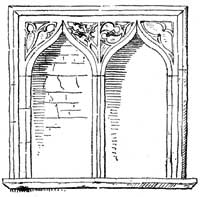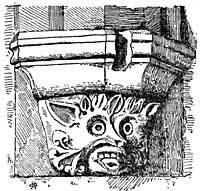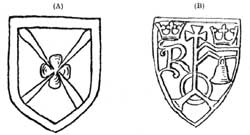
The screen and the chancel arch were removed from their original position in 1898, and re-set where the altar rail formerly stood. In the south wall, just beyond it, are the sedilia, i.e. the seats whereon the ministrants could sit during certain intervals in the celebration of mass. This is the only village church in the county wherein two ungraded seats were provided. In every other chancel there was either one seat, or three, according to the size of the church. It is probable that the chantry priest who performed his special duties at the altar in the south aisle, and who, in the ordinary way, would assist the parish clerk to sing, would have equal dignity here with the officiating priest. The seats are recessed "or cuttee into the walle" as the old phrase has it, and have ogival arches, the spandrels of which are filled in a clumsy manner with sunk tracery panels of varying designs, as though an apprentice hand had been trying what he could do to imitate the flowing lines of the window tracery. The whole is enclosed within a square frame of moulded stone. Eastward of the sedilia are two square recesses side by side; as in the south aisle the easternmost is a piscina with bason and drain, the other is arranged so that it might be used as a credence.
With the advent of the 15th century came a desire for more light within the church, and so the mason was set to work again to raise the walls of the nave and to make a range of clerestory windows on either side, while the carpenter was employed to frame a new roof. In order to accomplish this work the old arcade on the south side was cleared away, and a new arcade of four bays was erected on the old foundations.
The capitals of the piers are not very regular, it is true, and the base mouldings have been shorn off on the south side, but in all other respects the workmanship is good and sound to-day, and the proportions are very pleasing. The arches are in two orders and have plain chamfers.
The corbels which support the chancel arch, the responds to the arcade, and the corbels to carry the roof trusses are all carved with grotesque faces. It is difficult to determine what meaning, if any, these may have had.
It is quite noticeable how frequently the numbers two and four were employed throughout this church. Individually these instances are of no moment, but collectively they maybe significant. There were four bays to the nave arcade; four clerestory windows on either side, each of two lights; a four-light window in the north wall; four panels on either side of the central opening in the screen; double sedilia; double piscina in the chancel, and again in the south aisle; and more remarkable still twin-windows in the eastern wall of the chancel.

But what makes this church so very interesting is, that it was built not under monastic influence, not by a trained band of itinerant craftsmen, but by village workmen, at the behest of the village squire. This is the explanation of the window having been cut out of a slab of stone. I venture to suggest that the stone windows were wrought under the direction of the village carpenter, in the vernacular method, just as, at a later time, the oak screen was made by the village mason.
The plain octagonal font which stands under the tower belongs to the "Decorated" period. It is in gritstone, lined inside the bowl with thick lead. The scars in the brim indicate where staples for fastening the cover have been torn away.
Several incised grave covers of this period are also still to be seen; one has been used to form a window on the west side of the porch, while others lie in the floor of the tower. One of these has a fragment of the inscription still legible on the margin, HIC • JACET • DOMINUS. This may have been used to cover the grave of a former rector, who lived while these works were in progress, Thomas de Outhorp, who was instituted 23rd September, 1369, died 1415, and was buried in the chancel.
Although there are so few monuments of note, an account of West Bridgford would be incomplete without a brief reference to the celebrated "stone-man," which, after many vicissitudes, has found asylum in the new morning chapel, where a 14th century sepulchral arch, removed from the old chancel, has been re-set to accommodate it. Its early history seems to belong to the world of shadows, for who can say whence it came! Our earliest actual knowledge dates from the close of the 18th century, when the effigy was standing upright to mark the manor boundary near to the junction of the roads which lead to Melton and Loughboro' respectively. It must once have occupied a place of honour in a village church; the coat armour fixes the period of life between A.D. 1277-1310; and seeing that it is executed in similar stone to the 14th century windows in this church, there is strong presumptive evidence that it represents Sir Robert Luterell, who was lord of the manor early in the 14th century, whose widow, Johana, is known to have presented an acolyte, one Andrew Luterell, to the rectory in 1315, and whose chantry in the south aisle was the cause and starting point of all subsequent developments.
The Luterells were patrons during the 13th and 14th centuries,1 and at least three members of the family filled the office of priest. In those days when the walls and the windows of the church were all ablaze with colour, the Luterell arms Azure a bend betweent six martlets argent were conspicuously emblazoned.

The embattled, pinnacled tower of three stages was added early in the 16th century. It is substantially built with ashlar masonry in large blocks of river-borne stone from the Castle Donington district, in a somewhat debased style of Gothic architecture. The belfry has a stone vaulted roof and contains three bells, two of which are pre-Reformation bells, the third (No. 2 bell) was replaced in 1813 by J. and E. Smith, of Chesterfield. The fore-bell is the Angelas before referred to: it bears a founder's mark, occasionally to be met with in this district, which may have been used by Richard Mellers, but on this point there is some uncertainty (A); but of No. 3 bell there can be no doubt, for it bears his favourite and exclusive mark (B). A text in Lombardic capitals encircles the waist —
![]()
Latin equivalent of the couplet—
"Be Christ the King of Heaven,
Pleased when this sound is given."
Richard Mellers, the "bellyetter" was the husband of Dame Agnes Mellers, the foundress of the Nottingham Free School, and seeing that he died A.D. 1507, this bell would be one of the three bells which were handed to the "parson" by the commisioners in 1553.
Contemporary with the tower are two windows which have superseded lancets in the south wall of the chancel, and the embattled parapets to the nave and south aisle, executed in large blocks of magnesian limestone obtained from the coal measures.
 "Christus
Lapis Adjutorii".
"Christus
Lapis Adjutorii".Externally, the charm of the old church is now somewhat overshadowed, but interest may still be aroused by the tracery of the eastern windows; the grotesque gargoyles (one at the S.E. angle is modern); the carved stone in the south face of the tower, "Christ the Stone of Help"; and a number of 18th century headstones in the graveyard obtained from the Swithland slate quarries in the neighbouring county of Leicester. The charming grey-green colour of the stone, the graceful character of the lettering and scrollwork, and the quaint phraseology of the inscriptions make them worthy of more than passing notice.
The registers commenced in 1559. They are neatly written on parchment, and contain much interesting and valuable information concerning the church and the parish.
After hearing the above paper, members adjoined to the Old English Cafe, in Arkwright Street, where tea was very kindly provided by Sir Jesse and Lady Boot.
On returning to town, the party assembled about 5 p.m. in increased numbers at St. Peter's Church, where the following paper was read by Mr. Robert Evans.
(1) The first Luterell presentation was 1239: the last 1415; the estate passed to the Hyltons by marriage, c. 1470..
